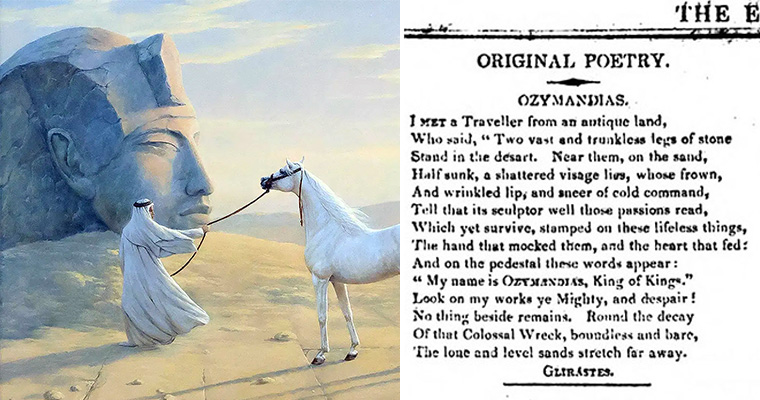
Jeffrey Eisenberg and I were looking though a pair of antique doors at Austin Auction Gallery when I saw a remarkable oil painting on the wall behind them and whispered in wonder, “Ozymandias.”
The auction catalog described the painting as, “Arabian horse and handler with Egyptian sphinx, signed lower right Maksymilian Novak-Zemplinski (Polish, b.1974), dated 2000.”
But I knew that painting for what it was. I’ve loved “Ozymandias” since the 9th grade.
You remember it, don’t you? Bryan Cranston read that famous poem in the final episode of “Breaking Bad.” The title of the episode was “Ozymandias,” and TV Guide picked it as “the best television episode of the 21st century.” It was also the only episode of a TV show ever to achieve a perfect 10-out-of-10 rating on IMDb with over 200,000 votes, putting it at the number one spot for the most highly rated television episode ever:
I met a traveller from an antique land,
Who said—“Two vast and trunkless legs of stone
Stand in the desert. . . . Near them, on the sand,
Half sunk a shattered visage lies, whose frown,
And wrinkled lip, and sneer of cold command,
Tell that its sculptor well those passions read
Which yet survive, stamped on these lifeless things,
The hand that mocked them, and the heart that fed;
And on the pedestal, these words appear:
“My name is Ozymandias, King of Kings;
Look on my Works, ye Mighty, and despair!”
Nothing beside remains. Round the decay
Of that colossal Wreck, boundless and bare
The lone and level sands stretch far away.
When I returned home from the auction, I spent a delightful 90 minutes tracking down all the bits and pieces of how that poem came to exist.
It was in 1817 that Percy Bysshe Shelley and his poet friend, Horace Smith read the news that the carved head of Egyptian Pharaoh Ramesses II had been removed from its tomb at Thebes by an Italian adventurer and that it would soon be traveling to Britain.
Shelly suggested to Smith that each of them should write a poem about it and title each of their poems “Ozymandias,” the Greek name for Egyptian pharaoh Ramesses II.
Look at the poem as it appeared in newspaper on that day in 1818, and you will see that Percy Bysshe Shelley signed it, “Glirastes.” He did it as an inside joke intended only for his wife, Mary Shelley, who, incidentally, published her famous novel “Frankenstein” that same year.
Mary often signed her letters to Percy as “your affectionate dormouse.” So Percy combined “Gliridae” (Latin for dormouse) with “Erastes” (Greek for lover) to create “Glirastes,” (meaning “lover of dormice.”)
So now you know how Google’s second-most-often-searched poem came to be published without anyone in London suspecting that it had been written on a bet with a friend by one of the most famous poets on earth who chose to sign it with a pseudonym as an inside joke to his wife.
Did you know that I became an ad writer only because it was impossible to support myself as a poet?
Now that you know that, you will not be surprised that Indy Beagle has collected Google’s Top 20 Poems for you to read in the rabbit hole. Indy also found the Horace Smith version of Ozymandias, and added it at the end of the Google’s Top 20 list.
To enter the rabbit hole, all you have to do is click the image that appears at the top of today’s Monday Morning Memo. You’ll find this memo archived as “Looking Though Antique Doors,” the Monday Morning Memo for October 20th, 2025.
This is the Google Top 20 List:
- “The Road Not Taken” by Robert Frost
- “Ozymandias” by Percy Bysshe Shelley
- “Sonnet 18” by William Shakespeare
- “The Raven” by Edgar Allan Poe
- “Do not go gentle into that good night” by Dylan Thomas
- “She Walks in Beauty” by Lord Byron
- “Because I could not stop for Death” by Emily Dickinson
- “O Captain! My Captain!” by Walt Whitman
- “I Wandered Lonely as a Cloud” by William Wordsworth
- “The Love Song of J. Alfred Prufrock” by T.S. Eliot
- “Stopping by Woods on a Snowy Evening” by Robert Frost
- “Annabel Lee” by Edgar Allan Poe
- “If –” by Rudyard Kipling
- “Invictus” by William Ernest Henley
- “I Wandered Lonely as a Cloud” by William Wordsworth, “
- “Ode on a Grecian Urn” by John Keats.
- “The Charge of the Light Brigade” by Alfred, Lord Tennyson,
- “Jabberwocky” by Lewis Carroll.
- “The New Colossus” by Emma Lazarus
- “The Song of Hiawatha” by Henry Wadsworth Longfellow
Ciao for Niao,
Roy H. Williams